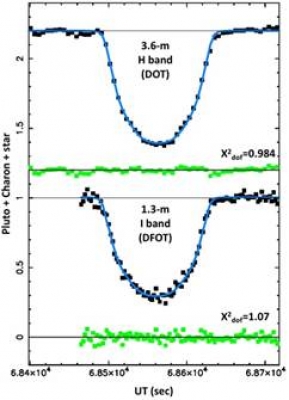New Delhi, Feb 16 : A multi-national team of scientists-collaborators has derived the accurate value of Pluto’s atmospheric pressure at its surface: it is more than 80,000 times less than the atmospheric pressure at mean sea level on Earth.
The pressure was calculated from data obtained by observation of stellar occultation by Pluto on June 6, 2020 using 3.6-m Devasthal optical telescope (DOT), India’s largest optical telescope, and 1.3-m Devasthal Fast Optical Telescope (DFOT) located at Devasthal, Nainital.
An occultation happens when a celestial object gets hidden from the view of the observer due to another celestial object passing in between them.A compilation of 12 stellar occultations by Pluto observed between 1988 and 2016 showed a three-fold monotonic increase of atmospheric pressure during this period.
The international team of scientists, including members from Aryabhatta Research Institute of Observational Sciences (ARIES), used signal-to-noise ratio light curves obtained from the sophisticated instruments used in the observations to derive an accurate value of Pluto’s atmospheric pressure at its surface.It was found to be 12.23 Ibar — 80,000 times less than the atmospheric pressure at mean sea level on Earth.They also found that the pressure at the surface is close to the seasonal peak of Pluto.
The research, published in Astrophysical Journal Letters (ApJL), showed that since mid-2015, Pluto’s atmosphere is in a plateau phase close to peak and is in excellent agreement with the model values calculated earlier by the Pluto volatile transport model in 2019.The team explained further that this occultation was particularly timely as it can test the validity of the current models of Pluto’s atmosphere evolution, a release from the Ministry of Science & Technology said.
The study also confirms earlier findings that Pluto suffers intense seasonal episodes because of large depression on Pluto, known as Sputnik Planitia.
Pluto’s poles remain, for decades, in permanent sunlight or darkness over its 248-year long orbital period leading to strong effects on its nitrogen atmosphere that is mainly controlled by vapour pressure equilibrium with the surface nitrogen ice.Moreover, as Pluto is now moving away from the Galactic plane as seen from Earth, stellar occultations by the dwarf planet are becoming increasingly rare, making this event a decisive one, the release added.niv/vd
Pluto’s poles are for a long time in perpetual darkness or light throughout its 248-year orbital time, causing significant impacts on the nitrogen atmosphere, which is primarily controlled by equilibrium of vapour pressure with the nitrogen ice on the surface.Furthermore that, as Pluto is distancing itself from the Galactic plane as seen from Earth as well, stellar occultations due to Pluto’s dwarf planet are becoming more rare and this makes this event a crucial one, the release said.







